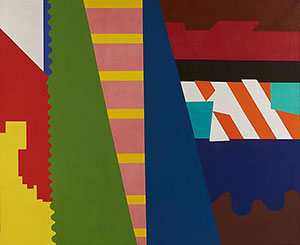Tibor de Nagy Gallery Shirley Jaffe / Kyle Staver Oct 17 - Nov 23, 2013 back

Shirley Jaffe
The First Diagonal
1973
oil on canvas
72½ x 88½ in

Kyle Staver
Syrinx
2013
oil on canvas
68 x 52 in
That Old Plastic Sense
Why is it that one of the least appetizing words in the English language illuminates some of our most transcendent experiences? Applied to the arts, the word “plastic” has of course nothing to do with PVC or polyethylene, but rather the emotive shaping of elements within a whole. As the music critic B.H. Haggin wrote:
…the continuum of sound moving in time is a plastic medium; and in the changes of sonority and pace which inflect the contour of the melodic line and shape the tonal mass in a Toscanini performance, one hears the operation of an unerring plastic sense on that medium — a plastic sense which makes each change of sonority or pace proportional to what precedes and follows…*
As many artists will tell you, “plasticity” applies no less to painting, a discipline that begins with marks on a surface, and ends up, with a little luck and much hard work, as complete and meaningful expressions.
Tibor de Nagy’s inspired pairing of exhibitions reminds us that, in regards to contemporary painting, plastic expression remains as varied as artists’ temperaments. The gallery’s main space features six large, geometric abstractions from the 1970s by the Paris-based painter Shirley Jaffe (b. 1923). The artist’s elegant, planar colors pulse across these canvases in a profusion of shapes: polygons with looping or saw-tooth edges, ziggurat-like forms, stacks of triangles, thick serpentine or zig-zagging lines. In the six-foot-tall “The first Diagonal” (1973), two triangles – one dark bluish-green, the other olive-green, with a busily scalloped edge – stretch the painting’s full height, held apart by a ladder of yellow and muted pink bars. A dance of notched, striped and billowing forms surround them, each a new, spry hue: blue, orange, warmer and barely cooler reds. If Jaffe’s color seem charged from within, almost primal in their elegance, her shapes seem consciously applied from without, steered by a playful cognizance of geometric possibilities. The artist’s enthusiasm is infectious, inviting the viewer into a frolic that feels at once footloose, wise and contained.
In the gallery’s smaller space, the four large canvases by Kyle Staver are unwise, uncontained, and thrilling. Can an artist really paint, in 2013, lyrical updates of classical myths? Absolutely, it turns out, if you possess this artist’s luminous command of paint. Some gallery-goers may already be familiar with Staver’s sensuous summarizations of people, animals and trees in brushy sweeps of color. These latest works adopt a more mysterious tone, thanks to the dark strangeness of her settings: all seem to be nocturnal or undersea scenes, with close-toned colors rumbling through rich darks, their edges caught occasionally in arcs of light. In a typical moment, a figure’s shadowed flank – deep, humming burnt sienna – glows uncannily next to a sky of jewel-like, midnight blue. (For me, it recalled a long-ago experience of a field of blazingly yellow mustard on a moonless night; it shimmered dimly, like black-green lava.)
Staver is a natural colorist, and such gambits of hue resonate throughout these paintings. But most impressive ultimately is her discipline of rhythm. In “Groupers” (2013), an exuberantly pink diver, her hair and legs curling backwards like a human shuttlecock, descends to within inches of her counterpart: a dark, barely visible figure – drowned, possibly? – curling the opposite way. A school of immense fish, their mouths identically agape, surrounds them in a sonorous arc. Staver’s colors weight each unfolding event: sinking, converging, pausing. In “Syrinx” (2013) all movements revolve beneath a single point: the crosshairs of tree’s branches over a moon, held at a remarkable distance and height by the intruding darkness and overlapping branches. An array of creatures – woman, deer, and the goat-legged Pan – pose below at various heights, their legs meandering towards and intertwining in the depths far below – in the “strange seas of thought,” as one writer described certain late works by Beethoven.
Both paintings go beyond merely diverting effects or stylistic adventures. Both convince, not through mere depiction, but through a momentum of color and form uniquely characterizing every event. They reflect, in short, an “unerring plastic sense of the medium.”
Now if only there was a more appealing word than “plastic”…
Tibor de Nagy Gallery
724 Fifth Avenue, New York NY 10019
212 262 5050 · www.tibordenagy.com back